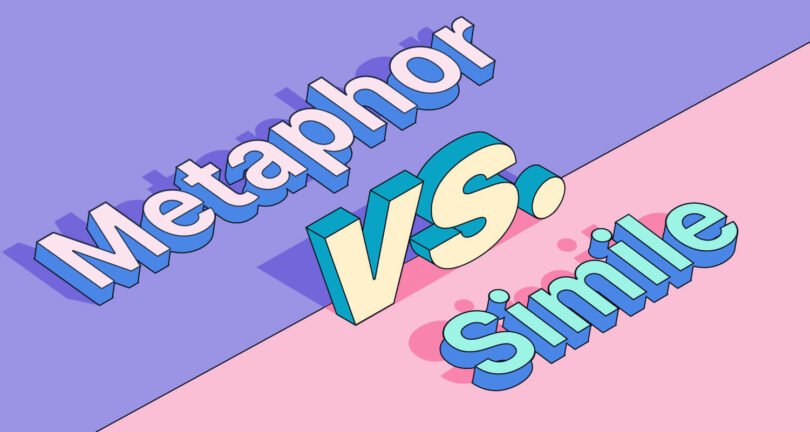What is a metaphor? To put it simply, a metaphor is a speaking form that uses an implied contrast. Terms of idioms that are frequently used to describe one group of objects or thoughts are applied to something other. It is what is a metaphor. Examine some metaphors to better understand what is a metaphor…
What is a metaphor? To put it simply, a metaphor is a speaking form that uses an implied contrast. Terms of idioms that are frequently used to describe one group of objects or thoughts are applied to something other. It is what is a metaphor. Examine some metaphors to better understand what is a metaphor and the purpose of this literary expression. We have compiled each detail of what is a metaphor in this article.
What is a metaphor?
Metaphors are described in various ways. It derives several meanings. We are here to make you aware of what is a metaphor exactly. Metaphors are often used as strategies that are not true. What is a metaphor? They are examples of figurative language, which is used to express notions different than the words’ denotative, literal meanings. In addition to other types of writing, what is a metaphor? They are used in speeches, casual conversations, and creative writing like poems and novels. In other words, what is a metaphor? When two words having opposite meanings are employed to describe a thing or a circumstance, a metaphor is produced. It is frequently employed in comparison sentences. Your sentences sound nice even if they aren’t entirely accurate. This post will provide all the information you need to know about what is a metaphor.
The root word of Metaphor
Before going any further, let’s look at the base of the metaphor. It’s been around since the fifteenth century. However, there are multiple roots. Through the Old French word métaphore, the English language was introduced to the Latin word metaphor. Furthermore, the Greek word metaphorá, which means to convey, is the source of the Latin word metaphorá. In the broad scheme of things, the metaphorical meanings of all three of these languages are extremely similar. When something is carried over or transferred, it refers to the comparison of the qualities. Comparison of one thought or item to those of another.
Before moving on to the types and other facts you should be aware of what is a metaphor. Let’s first talk about how to recognize a metaphor.
To help you identify a metaphor, keep in mind the following points:
- It is important to understand when two words are being compared while still having completely different meanings. Common metaphors include, among others, “cold feet,” “black sheep,” and “silent laughing.”
- As a result, you should be aware that a metaphor that reads “a snake resembles a worm” is not one. It is because it is literary true. However, as was said in the aforementioned examples, a sheep is never black, and laughter cannot be silent.
- A metaphor will always imply that the other is something wholly unconnected to it.
- Comparisons that are used to enhance a statement rather than because they are related are called metaphors.
- You will read a statement and find two terms comparing two unconnected objects. In that, you will realize it is a metaphor. Writing metaphors are often used in literary works like poetry or fiction.
Examples of Metaphors
These are illustrations that make a strong point by contrasting two things you might not ordinarily pair together:
Metaphors relating to emotions
They can be useful in expressing the type or degree of feelings:
- His words had the edge of a blade. Sharp objects don’t just arise out of thin air. In this analogy, someone has hurt another’s feelings by saying anything.
- I can already smell failure in the air. Although failure doesn’t smell, it’s also not enjoyable. Therefore, this metaphor suggests that one of life’s shocks is about to happen.
- I’m drowning in a sea of grief. In this situation, the person’s sorrow is so intense that they experience helplessness and sinking an emotion.
- I am feeling blue. Until we adopt the appearance of the young girl from Willy Wonka’s Chocolate Factory; none of us are likely to turn as blue as a blueberry. This metaphor represents sadness.
- She is going through a rollercoaster of different emotions. Our emotions are unable to experience a rollercoaster. The only meaning this metaphor serves to convey is that the subject goes through a wide range of emotions.
Metaphors relating to Behaviors
- He Flared up my temper. You don’t explode into flames when someone gets on your nerves; you just get irritated.
- He reeks of disloyalty. When this is said about an unfaithful partner, it doesn’t always mean that there is a real odor. This metaphor makes it quite evident that the subject is a thief and a liar.
- I think he is about to fade off to sleep. Thankfully, none of us vanish into thin air when we turn in. Simply put, this expression indicates that someone has dozed off.
- She was fishing for appreciation. In reality, the woman isn’t tossing a lure into the water in hopes of getting compliments. Instead, it is a dead metaphor that connotes a desire for approval.
- She has a bubbly personality. Nobody’s personality can come to life like a bubbling glass. This metaphor is used to describe an especially joyful person.
Heartbreak and Love Metaphors
Talk about love and loss and metaphors are often used:
- He broke my heart. You feel miserable and heartbroken even when your heart isn’t crushed.
- She is an apple of my eye. There isn’t an “apple in anyone’s eye,” of course. Someone cherishes the apple.
- A flame of love. Of course, love isn’t fire. But if you want to express a passionate but dangerous relationship, this metaphor can work well.
Setting Metaphors
It’s sometimes helpful to describe the scene using a metaphor:
- The curtain of night fell upon us. No silk evening curtain materialized. The sky suddenly became dismal. A few simple phrases can convey a vivid picture of how quickly night fell.
- The sun is a creature of habit. The sun is not a living entity. This metaphor nevertheless conveys the regularity and occurrence of sunsets and sunrises.
Another popular metaphor
- Time is a thief. Thank goodness, time doesn’t don a ski mask and disappear into the night. This metaphor emphasizes how quickly time passes and how short our lives are.
- This is the icing on the cake. The cake is typically enjoyed, although an iced cake is preferred. This suggests that something extraordinary has happened to enhance a favorable situation.
- Hope is on the horizon. Ope is an invisible phenomenon; it doesn’t float along the horizon. This metaphor implies that one’s future is filled with hope.
Types of Metaphors
Direct Metaphors
The first metaphor is direct. It is the simplest to utilize, especially for those learning a new language. My sibling is being referred to here as an animal, which is a physical impossibility. However, if an animal’s characteristics—in this example, untamed and possibly aggressive—are taken into account. My brother’s actions on the sports field can be recognized. A straightforward metaphor is typically a comparison that is clear from the context. Although there are many prevalent direct metaphors. Anything can serve as an example as much as the connection can be presented clearly and directly. If not, then it serves as an instance of a straightforward metaphor gone wrong.
- Example: He was a fish out of water in his new job.
- Mary is a bit of a couch potato.
Extended Metaphors
Another common literary device is the extended metaphor. It is just an expanded version of an existing metaphor. An extended metaphor is a term used in literature. It describes when a writer compares unrelated ideas or objects throughout several phrases. A single sentence, a whole chapter, or even an entire book could employ this literary technique repeatedly. An author may employ extended metaphors in the setting, situations, characters, or ideas of a novel. An extended metaphor is also known as a conceit or sustained metaphor.
- Example: “Two roads diverged in a yellowwood”, means difficult choices are made alone.
Implied Metaphors
Instead of a direct comparison, the metaphor in this case is implied. Again, the analogy cannot be taken too literally. Because no weight is being applied. Yet, it takes only a small amount of thought to grasp that stress limits us in some manner. Because we carry it around with us like a heavy bag. Even though there isn’t a direct comparison being made; the situation is inferred by the language and context that we use. Implicit metaphors abound in literature and music, giving the language a poetic quality. However, they are also a powerful tool for communication that encourages feelings of understanding and empathy. They regularly appear in headlines in the media to increase the impact of a story.
- Example: The flowers danced in the wind.
- Poem “Fire and Ice” by Robert Frost
Dead Metaphors
Dead metaphors are linguistic linkages that don’t, for one reason or another. Make any more logical sense or have any type of impact on their visual picture. A metaphor may have become overused to the point. It no longer has any meaning and has fallen into the realm of cliché. In other words, the dead metaphor offers a reference to actual motion rather than symbolic form. A dead metaphor is only a comparison that is overlooked. Since it is based on a contrast that has merely become embedded in the language. It uses a term that is widely used.
- Example: It is raining cats and dogs.
- Time is running out.
Mixed Metaphors
The mixed metaphor is one of the most common types of metaphor, however, these can be difficult to understand. When two completely unrelated ideas are united, a mixed metaphor occurs. Yet, the comparison’s symbolic meaning is nevertheless made evident. On occasion, the mixed metaphor may be intentionally used for impact. Here are two interesting and entertaining historical events:
- Examples: They’ve put all their eggs in one basket and it’s misfired.
The Purpose of Metaphors
- Metaphors are used in communication to help demonstrate or explain something by linking it to another item. Metaphors achieve several objectives:
- Improving the ability to visualize fresh ideas
- Successfully explain unusual circumstances
- The words and conversations of others with variety and interest
- Showcase striking images to leave a lasting impression.
- Blend the concrete with the abstract
- Readers and viewers are influenced
Relevant things you must know about Metaphors
- Metaphor is a Strong Spice
Avoid using too many analogies. Not every word in a sentence needs to be a metaphor for another idea. Occasionally, the message needs to be communicated simply, without adding further layers of abstraction.
- Poe, Tray
Learning to appreciate metaphors in your brain requires reading poetry. There are many of them. from every geographic location, both historic and contemporary. After that, write it. Poetry frequently acts as a doorway to a fantastical world of metaphor. What else might serve as a portal to a metaphorical wonderland? Churros. Mmm. Churros.
- Comparison of Two Dissimilar Items
A metaphor is a tiny bit of literary magic. It lets you, the author, draw an unexpected parallel between two unrelated things. You are contrasting and connecting things that you shouldn’t be. How do wasps and mechanics differ from one another? like a banana-sized thundercloud? How do you talk about a nuclear winter and create a beautiful symphony? By holding up one object—a double-headed dildo—and demanding that the readers understand another. A floppy slice of freshly baked zucchini bread—the author employs a metaphor to illustrate their argument. It is a violation of expectation and an attack on the pictures. A change occurs in metaphor. Given that they both possess “meta” and “pho,”, that’s the case.
Making Use of Metaphors
By using metaphors, you can alter both your explanations and the images you’re trying to paint. Some of the strongest parallels may be forgotten by readers who are absorbed in your writing.
But why do they work there?
Writers will use metaphors when they want to give their writing a fresh, unique perspective. Many readers claim that after finishing a good book, they can mentally see the characters and the story’s events. Sometimes metaphors can be utilized to achieve this. Metaphors are used in a variety of contexts, not just in books and short stories. Many poets use metaphor to express a thought or emotion. Two thoughts can be communicated in a poem with sufficient writing.
Winter Trees, one of my poems, serves as an example of this. This is about getting older and not realizing the advantages of youth while neglecting its disadvantages.
The lines that follow are an expression of these words:
‘Decorated in baubles and winter soldiers.
I used to be pretty too, think the winter trees.’
The first statement above illustrates the speaker’s viewpoint on the younger people in her local vicinity. While the second expresses her remorse about her beauty. Although the entire poem is meant to be a metaphor, at first glance it seems to be about trees.
Metaphor: Dos and Don’ts
Dos
- Mix up the metaphors you employ in your writing.
- Take care when using.
- The second or third metaphor that comes to mind should be used. (The first illustration can be overused.)
- When utilizing metaphors, establish a contrast that readers can understand.
- Use a metaphor that supports your writing.
- To become comfortable with metaphors, spend some time comparing objects in your home or people you know to other objects. (This can help you distinguish between common and rare similarities.)
- Look for metaphors in the poems and tales you read. (This will show how common they are and assist you in figuring out what functions or don’t. It enables you to apply them to your writing or assists you in avoiding making the same mistakes.)
Don’ts
- Do not overuse them on the page. (When it comes to the employment of metaphors, more is preferable because otherwise their impact would be diminished).
- Avoid employing them if you know they will weaken rather than strengthen the descriptions.
- Avoid muddy metaphors while writing something vital. (These can make you sound silly or funny. It is if you’re in an emotional scenario, that can make a serious issue seem less serious.)
- Be careful not to use cliches and metaphors.
- Don’t use metaphors that detract from the story.
- Never be afraid to attempt anything new. (Even if you don’t use metaphors often, practicing them will help you get better at them.)
A Simile and A Metaphor
Comparisons are used in both metaphors and similes to give readers a clearer picture than a plain description. Similarities can also be used to achieve this. While comparisons are still made, an analogy also includes similes, metaphors, and additional information in addition to comparisons. It paints the scene more vividly. For example, “Her hair flew back and forth in the wind like an uncontrollable river.”
Difference between Simile and Metaphor
What, therefore, separates a simile from a metaphor? Similes are shorter than comparisons but less straightforward than metaphors since they compare items using the terms “like” or “as.” The phrase “Her hair was like a chaotic torrent” can be used to describe something If you want to simplify this, you may say, “Her hair was a chaotic river.” If you ever need to stick to a strict word restriction while delivering the same idea, the shorter metaphor is one strategy to help reduce the word count without sacrificing any of the plots. Although all similes are metaphors, not all metaphors are similes.
Continue reading if you’ve ever wondered how metaphors and similes are different. Here is a prompt reply:
A metaphor involves an indirect comparison, whereas a simile makes it clear that the object or thing being compared is to another.
- Using the word “is” creates a metaphor.
- “As” or “like” are used in a simile.
Another metaphor is “their home was their prison.” An analogy would be, “Their home was like their prison.” Here is an example of how an analogy could be used to make the same point. They were stuck inside their house for weeks due to the persistent rain, and eventually, it turned into a jail.
There is more information given, but there are also more words utilized. But there were no visiting hours, and no one had called for days. As with any strong analogy, a writer may go further and employ various metaphors to emphasize their point. When would they be able to escape from their cell? They thought.
Very dramatic and perhaps a bit exaggerated, but you get the point.
It’s time to practice some metaphors
I genuinely hope that this guide on effectively employing metaphors proved helpful to you. Each type that you can use in your composition serves a certain function. You can write successfully and with interest by using the right metaphor. Practice reading over a previously written story while substituting metaphors for some of the specifics. Which of the two is more interesting to you, and why?
Takeaway
When trying to come up with a good metaphor, use your creativity. When writing a term that is challenging to define literally, you can employ a metaphor. You cannot make such a reference to a list of metaphors. All you need to do to use beautiful metaphors is consider the context. Learn more about the subject to come up with an amazing metaphor. The best part is that there aren’t many limitations on how metaphors can be used. All that needs to be taken into account is the reader’s capacity. It is to comprehend what the speaker is attempting to convey. As can be shown, new metaphors can always be developed. They are easy to understand and relate to, despite the vast number of metaphors that are already in use. They provide an additional degree of excitement even when things go wrong, as can be observed.






